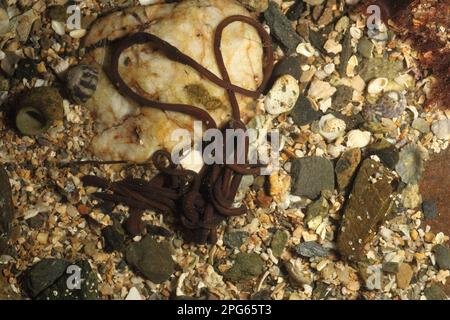
Bootlace worms are intriguing not just for their appearance but also for their remarkable behavior during low tide. You might be wondering how these creatures thrive in such a challenging environment. Their adaptability is nothing short of impressive. To help you grasp their incredible lifestyle, we’ll dive into their behavior, particularly during those low-tide moments, in a way that’s engaging and easy to understand.
What Exactly is a Bootlace Worm?
Bootlace worms, scientifically known as *Lineus longissimus*, are fascinating creatures found in the shallow waters of the North Atlantic. They can grow to astonishing lengths—some even reaching up to 30 meters! While they may look like long, thin strands of spaghetti, they belong to a group called ribbon worms. These worms have a unique ability to extend and contract their bodies, allowing them to navigate their environment skillfully.
As bizarre as their appearance might be, bootlace worms play an essential role in their ecosystems. They feast on small invertebrates and even dead organic matter. This means they help recycle nutrients back into the marine environment. So, the next time you see one, remember, it’s not just a strange-looking worm; it’s a vital player in the seaside ecosystem!
The Fascinating Behavior of Bootlace Worms
One of the most captivating aspects of bootlace worms is their behavior during different tidal conditions. When the tide is high, these worms are often submerged, curling up in seaweed or hiding in sandy bottoms. However, when the tide drops, they reveal a different side—one filled with exploration and survival instincts.
During low tide, bootlace worms can be seen emerging from their hiding spots. They often stretch out to soak up the sun and blend into the environment. Their primary strategy is to move slowly and deliberately to avoid predators and to find food. This behavior allows them to thrive even when the water level is low, demonstrating their adaptability.
How Bootlace Worms Handle Low Tide Challenges
You might be curious about how bootlace worms manage to survive when they find themselves stranded on the beach at low tide. The secret lies in their ability to breathe through their skin. As the water recedes, they absorb moisture from the sand, allowing them to stay hydrated despite being away from the water. It’s like they carry their own little water supply!
Moreover, when threatened by exposure or predators, these worms can burrow into the sand. This behavior acts like a protective shield, helping them evade danger. Their ability to blend in and hide emphasizes just how well adapted they are to their tidal environment.
Bootlace Worms and Their Habitat
Bootlace worms thrive in various coastal habitats, including sandy bottoms and rocky shores. You can often find them hidden beneath rocks or in the crevices of tidal pools, where they find shelter and food. During low tide, these worms utilize their environment to their advantage, stretching out to catch food or find a safe place to hide.
Their habitat not only provides food but also offers protection from larger predators. The organisms around them, like shellfish and algae, serve as both cover and a food source. It’s a delicate balance that bootlace worms navigate with ease. As they adapt to the ever-changing tides, they showcase nature’s cleverness.
Why Bootlace Worms Matter to Our Ecosystem
You might be wondering why we should care about a creature like the bootlace worm. Well, their role in the ecosystem is crucial. By consuming organic debris and small invertebrates, they help keep the marine environment healthy. This process is known as biodegradation, where they break down complex materials into simpler forms that other organisms can use.
Bootlace worms also serve as a food source for various animals, like fish and larger invertebrates. By being part of the food chain, they contribute to a balanced ecosystem. If bootlace worms thrive, chances are the entire coastal environment is doing well, showing just how interconnected our world is.
Encountering Bootlace Worms: What to Look For
When you’re exploring the beach during low tide, keep an eye out for these unusual creatures. Bootlace worms are often easy to spot if you know what to look for. Look for long, thin, squiggly shapes that might be slightly buried in the sand or hiding among seaweeds. You might even see them moving gracefully through tidal pools.
If you decide to observe them up close, be gentle. These worms are quite fragile and can easily be harmed. Plus, their vibrant colors can be mesmerizing—ranging from mild yellows to deep reds. Watching them move is not just fascinating; it connects us to the broader story of life in our oceans.
Bootlace worms are a unique and vital part of coastal ecosystems, particularly during low tide when they show off their impressive behaviors. By understanding their world, we appreciate the intricate balance of life beneath the waves. From their remarkable adaptations to their role in nutrient cycling, these worms remind us that even the most unusual creatures have a purpose.
So, the next time you’re at the beach and the tide goes out, take a moment to look for these ribbon-like wonders. They might just inspire a deeper appreciation for the intricate life teeming along our shorelines. Who knew a simple worm could teach us so much about resilience and the beauty of nature?
